A hold breaks, the leader falls and hangs freely in his harness without any contact with the rock. Since it can take time for air rescue to occur, there is a risk of developing hanging syndrome. Why hanging freely in a harness can be fatal and what climbers can do about it.
An article by Bernhard Bliemsrieder, Grasegger Katharina, Lechner Raimund, Peter Paal, Simon Rauch - first appeared in the specialist journal mountaineering
Suddenly, before the first hook, the leader's grip breaks and he falls to his stand with a lot of slack rope. The belayer is able to hold the fall and, shocked, immediately finds out about the condition of the fallen leader. He hangs freely in his harness without any contact with the rock and complains of severe pain in his right shoulder.
The belayer immediately makes an emergency call because rappelling together is out of the question due to the severe pain. After about ten minutes he receives a call back and it is explained that a rescue has been initiated, but that the arrival of the helicopter could take up to an hour.
Such a scenario can affect any climber in alpine terrain. In such a situation there is a risk of a so-called Hanging syndrome (English suspension syndrome).

What is hanging syndrome?
Hanging syndrome describes circulatory failure induced by motionless, almost vertical hanging in a rope harness.
First signs
The first symptoms are usually signs of impending loss of consciousness such as nausea, anxiety, visual perception disorders (e.g. flashes of light, “going black” in front of the eyes), dizziness, sweating and paleness. Loss of consciousness can quickly occur and, in the worst case, hanging syndrome can lead to cardiac arrest and death.
The term “hanging trauma” is usually found in the German-language literature, although the term trauma is misleading in this context since the patient does not necessarily have to have a mechanical injury (trauma).
Therefore - similar to the English "suspension syndrome" - the term "hanging syndrome" seems more correct to describe this symptom complex and should be used in the future.
Any person who carries out a rope-secured activity can be affected by hanging syndrome, especially (industrial) climbers, mountaineers, cave walkers, paragliders and rope-secured workers.

Why hanging in a harness can be so dangerous
The exact cause of hanging syndrome has been controversial for decades. In recent years, various experimental studies and hanging tests have provided insight into the genesis of hanging syndrome.
The cause of death is essentially one generalized reduced blood flow of the body, which causes multi-organ failure. Above all two mechanisms appear to play a relevant role in the development of hanging syndrome.
- On the one hand, due to gravity, blood accumulates in the veins of the hanging parts of the body, especially in the legs. This is exacerbated by reduced muscle activity, for example due to exhaustion, low blood sugar, pain, injuries, hypothermia or loss of consciousness. This in turn can lead to one Reduced blood circulation and thus damage to various organs .
- However, more recent studies suggest that the main cause of unconsciousness is a so-called vasovagal reflex response appears to be, which is characterized by a sudden drop in heart rate and blood pressure. This results in one Reduced blood flow and undersupply of oxygen to the brain, which in turn leads to unconsciousness. In addition, all muscles relax, so that in an unconscious patient tied to the rope, the rope point is the highest point.

Through this “arc-shaped” position (Photo above), backflow of blood from the legs is very restricted and the reduced blood flow to the brain cannot be reversed.
If the hanging period is long enough, this position can lead to the death of the patient.
The time until this vasovagal reflex response occurs is subject to individual differences and can in extreme cases only a few minutes be. The time between the appearance of the first symptoms and loss of consciousness is also very individual and, in the worst case, can be less than a minute.
Free hanging processes critical to survival
- If an unconscious person is secured to the rope, the head can bend due to gravity and thus the airway can be blocked, possibly resulting in death.
- A general lack of blood flow to the tissue leads to cell damage and thus to the formation of harmful degradation products.
- The congestion of blood in the leg veins, possible hypothermia and excessive muscle work due to self-rescue attempts promote cell damage, especially muscle cells, and thus multi-organ failure.
- In addition, a sharp increase in blood potassium levels as a result of cell damage can lead to life-threatening cardiac arrhythmias.
How to protect yourself: five preventive measures
1. Self or comrade rescue
Basically, the free hanging time should be kept as short as possible. This requires you to rescue yourself or your comrades as quickly as possible. The prerequisite for this is that the hanging person has self-rescue skills and also has the necessary material with them (recording cord, sling, clamping device, etc.).
However, if the hanging person is not able to save themselves, the development of hanging syndrome should be prevented as much as possible until rescue can be carried out by comrades or organized rescue.
2. Active movement on the wall
To reduce the accumulation of blood in the leg veins, the hanging person should actively move the legs, for example by "air cycling" or pushing the legs up on an accessible rock, crevice or building wall.
3. Step sling when hanging freely
When hanging freely, the muscle pump can be supported by using a self-attached step sling (Gallery image I).
4. Resistance with rope
If, on the other hand, the injured person is not attached to the end of the rope, he can stretch out his leg and push his body up by wrapping the hanging rope twice around his own foot against the resistance of the rope. The unwrapped leg can also be supported on the other foot. The activity in the leg muscles causes the blood in the veins to be pumped towards the heart (“muscle pump”).
5. Raised legs
Improving venous return from the hanging parts of the body can also be achieved by lifting the hanging legs by a rescuer or by attaching a (band) sling to the back of the knees (picture below).
If the person is unconscious
If the hanging person is unable to save themselves and cannot move actively, either due to exhaustion, injuries, pain, hypoglycemia, hypothermia or unconsciousness, the accompanying person's goal must be to get the hanging person as quickly as possible possible to free it from the rope and bring it to a place where it can be stored flat.
This means that in hanging syndrome - similar to avalanche rescue - the Self-rescue and comrade rescue are the most important links in the chain of survival and, in terms of their influence on survival, are to be rated significantly higher than organized professional rescue.
Tip
When buying a climbing harness, you should make sure that it fits your body proportions perfectly and allows you to hang as painlessly as possible. A suitable and optimally adjusted belt can reduce pain when hanging for long periods and thus prevent a reduced ability to move.
Vascular compression of the large leg vessels in the groin area does not occur when modern hip belts, such as those commonly used in mountain sports, are correctly applied and adapted to the body proportions. Hip belts with wide leg loops are preferable to those with narrow ones, although the hanging comfort also depends significantly on the cut and the (material) construction.
When hanging freely for a longer period of time, backpacks should be removed from the back and attached to the rope point, for example, in order to enable hanging to be as energy-saving as possible.
First aid for (professional) rescue
If, despite all precautionary measures, a fall has occurred with the following free hanging and a mountain rescue operation is in full swing, the (professional) rescue workers should take a few aspects into account:
- Naturally, patients who have suffered hanging syndrome are usually in terrain that is at risk of falling. The self-protection of the rescue workers has the highest priority.
- As long as the patient is conscious, emergency personnel should encourage him to activate the muscle pump as described above.
- If the patient is incapacitated, the first person to reach him should raise his legs to as horizontal a position as possible. In addition, if the patient is unconscious, a free airway should be ensured by stretching the head.
- Once the patient has been freed from the wall, he should immediately be placed flat and examined according to the internationally accepted C-ABCDE algorithm (see “Alpine emergency” in mountaineering #102)
- ECG monitoring should be established as early as possible due to the increased risk of cardiac arrhythmias (risk of increased blood potassium levels). Any cardiac arrhythmias that occur should be treated in accordance with current guidelines.
- An AED (automated external defibrillator, see mountaineering #101) should definitely be brought with you to the place of work.
- If there is a resuscitation situation, the standard resuscitation measures should be carried out as quickly as possible (see mountaineering #100).
- Advanced measures to treat elevated blood potassium levels are important for professional rescue workers.
- For longer periods of hanging, infusion solutions should also be administered intravenously to prevent kidney failure caused by cell decay products.
- If the patient was in a hanging position for more than two hours, the destination clinic should have a kidney replacement procedure.
- In addition, great importance should be placed on the prevention and treatment of possible hypothermia.
The most important things at a glance
Hanging syndrome is potentially life-threatening!
Main risks during hanging
Circulatory failure and airway obstruction
Main risks after patient rescue
- Arrhythmia
- Hypothermia
- kidney damage
- Self-protection always comes first!
Prävention
- Do not carry out rope-secured activities alone. A quick (self) rescue is of the utmost importance.
- Activation of the muscle pump (leg movement, pushing against the abutment). When hanging, assume a position that is as horizontal as possible, using auxiliary loops if necessary
- Optimal adjustment of the belt system
Treatment
Flat storage after rescue; The standard is the C-ABCDE algorithm
About the magazine bergundstieg

Bergundstieg is an international magazine for safety and risk in mountain sports and illuminates the topics of equipment, mountain rescue, rope technology, accident and avalanche knowledge. Bergundstieg is published by the Alpine Associations of Austria (PES), Germany (DAV), South Tyrol (AVS) and Switzerland (Customer Service).
That might interest you
- Belay construction for multi-pitch climbing | tips
- Strength endurance: You should avoid these 7 training mistakes
- Huge highball: This is how Keenan Takahashi climbs A little Life (8B+) | Video
+ + +
Credits: Cover photo argonaut.pro/paulitrenkwalder.com| mountaineering






